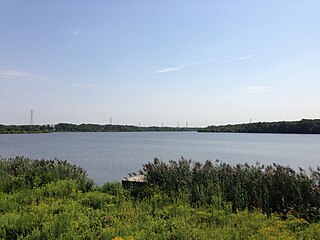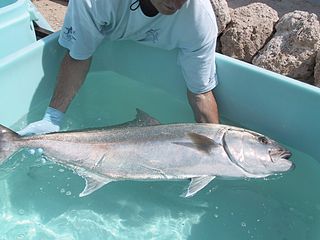
The tiger muskellunge, commonly called tiger muskie, is a carnivorous fish, and is the usually-sterile, hybrid offspring of the true muskellunge and the northern pike. It lives in fresh water and its range extends to Canada, the Northeast, and the Midwest United States. It grows quickly; in one study, tiger muskie grew 1.5 times as fast as muskellunge. Like other hybrid species, tiger muskie are said to have "hybrid vigor," meaning they grow faster and stronger than the parent fish, and are also less susceptible to disease. Trophy specimens weigh about 30 lb. Its main diet is fish and small birds. The tiger muskie and the muskie are called the fish of 10,000 casts due to the challenge involved in catching them.

The Lehigh River, a tributary of the Delaware River, is a 109-mile-long (175 km) river located in eastern Pennsylvania, in the United States. Part of the Lehigh, along with a number of its tributaries, is designated a Pennsylvania Scenic River by the state's Department of Conservation and Natural Resources. "Lehigh" is an Anglicization of the Lenape name for the river, Lechewuekink, meaning "where there are forks".

Fish stocking is the practice of raising fish in a hatchery and releasing them into a river, lake, or ocean to supplement existing populations or to create a population where none exists. Stocking may be done for the benefit of commercial, recreational, or tribal fishing, but may also be done to restore or increase a population of threatened or endangered fish in a body of water closed to fishing.

Senecaville Lake is a reservoir in Guernsey and Noble Counties, Ohio. It is located approximately 13 miles (21 km) southeast of Cambridge near the village of Senecaville, Ohio. The lake is popular among recreation and fishing enthusiasts. It is often referred to locally as Seneca Lake.

The Colorado Parks and Wildlife division of the U.S. State of Colorado manages more than 300 state wildlife areas with a total area of more than 860 square miles (2,230 km2) in the state. The Colorado state wildlife areas are managed for hunting, fishing, observation, management, and preservation of wildlife.

Mercer Lake, also known as Lake Mercer, is a man-made lake within Mercer County Park in West Windsor, Mercer County, New Jersey, United States. The lake came into being with the 1975 construction of a dam to control flooding on the Assunpink Creek in nearby Trenton by the United States Department of Agriculture Soil Conservation Service. The basin, now occupied by the lake, was excavated by crews building nearby Interstate 295 at no additional cost to taxpayers. The lake is the home of one of the US Olympic Rowing Team's training centers. It has played host to the 1988, 1992, 2004 and 2008 U.S. Olympic Team Trials for Rowing, in addition to USRowing National Team selection events, international regattas, and both collegiate and junior national championship regattas. The infrastructure and topography of the racecourse meets FISA standards and PNRA has the equipment necessary to host the world's largest regattas.Although Mercer Lake is one of cleanest bodies of water in central New Jersey, it still faces problems with pollution from nearby golf courses and storm water runoff.

The Bellvue-Watson Fish Hatchery is a Colorado Parks and Wildlife cold water fish production facility located near Cache la Poudre River and Watson Lake State Wildlife Area in Larimer County, Colorado. Hatchery staff works to support the raising of approximately 1.5 million sub-catchable trout annually. The Watson Lake Rearing Unit, a division within the hatchery, is responsible for rearing approximately 300,000 catchable trout each year. The hatchery stocks fishing sports in Wellington, Fort Collins, Loveland, Longmont and Jumbo Reservoir near Julesburg and Hale ponds.

The Crystal River Hatchery is a Colorado Parks and Wildlife cold-water fish production facility located along the Crystal River in Garfield County, Colorado, near Carbondale. The hatchery raises rainbow trout and Snake River cutthroat trout brood fish. The millions of eggs from these brood fish are shipped to other hatcheries to be raised for stocking.

The Durango Fish Hatchery is a Colorado Parks and Wildlife cold water fish production facility located near the Animas River in Durango, Colorado. The hatchery staff raise rainbow, brown, Snake River and native cutthroat trout, and kokanee salmon.

The Finger Rock Rearing Unit is a Colorado Parks and Wildlife cold water fish production facility located near Bear River in Routt County at the base of Flat Tops Wilderness Area.

The Glenwood Springs Hatchery is a Colorado Parks and Wildlife cold water fish production facility located on Mitchell Creek near the Colorado River in Garfield County, which is 2 miles north of West Glenwood Springs.

The John W. Mumma Native Aquatic Species Restoration Facility is a Colorado Parks and Wildlife cold water fish production facility located near Playa Blanca State Wildlife Area and Rio Grande river in Alamosa County.

The Mt. Shavano Hatchery is a Colorado Parks and Wildlife cold water fish production facility located near Arkansas River headwaters at the base of Big Baldy Mountain in Chaffee County. This facility is considered one of the largest trout units in the state.

The Pitkin Hatchery is a Colorado Parks and Wildlife cold water fish production facility located in Gunnison National Forest right off of Quartz Creek Valley in Gunnison County.

The Poudre Rearing Unit is a Colorado Parks and Wildlife cold water fish production facility located near Cache la Poudre River at the base of South Bald Mountain in Larimer County. It is considered one of the smaller units in Colorado.

The Pueblo Hatchery is the only Colorado Parks and Wildlife cold and warm water fish production facility located in Lake Pueblo State Park near Arkansas River in Pueblo County.

The Rifle Falls Fish Hatchery is a Colorado Parks and Wildlife cold water fish production facility located off East Rifle Creek near Rifle Falls State Park in Garfield County.

The Roaring Judy Hatchery is a Colorado Parks and Wildlife cold water fish production facility located on East River at the base of Flat Top mountain in Gunnison County. It home to the largest known kokanee salmon run in Colorado.
















